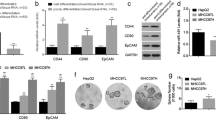Abstract
Metastasis and recurrence are the biggest obstacles to enhance the efficacy of surgical resection as a cure for hepatocellular carcinoma which is the second most deadly cancer in China. Here, we had showed that two DNAzymes (DRz1 and DRz2) targeted to IGF-II could inhibit invasion, motility and migration of SMMC-7721 cells in vitro. DRz1 was transfected into SMMC-7721 cells and the results were shown that IGF-II expression level dramatically reduced. Meanwhile, DRz1 effectively inhibited adhesion between SMMC-7721 cells with the extracellular matrix and Fb cells comparing to those untreated or transfected with inactive DRz (P < 0.05, ANOVA). Furthermore, vascular endothelial growth factor and matrix metalloproteinases were down-regulated in DRz1 treated cells. These results may help to identify novel therapeutic molecules targeting hepatocellular carcinomas.




Similar content being viewed by others
References
Abellan R, Ventura R, Palmi I, Di Carlo S, Bacosi A, Bellver M, Olive R, Pascual JA, Pacifici R, Segura J, Zuccaro P, Pichini S (2008) Immunoassays for the measurement of IGF-II, IGFBP-2 and -3 and ICTP as indirect biomarkers of recombinant human growth hormone misuse in sport. Values in selected population of athletes. J Pharm Biomed Anal 48(3):844–852
Akram SK, Akram M, Bhutta ZA, Soder O (2008) Human placental IGF-I and IGF-II expression: correlating maternal and infant anthropometric variables and micronutrients at birth in the Pakistani population. Acta Paediatr 97(10):1443–1448
Brown J, Jones EY, Forbes BE (2009) Keeping IGF-II under control: lessons from the IGF-II-IGF2R crystal structure. Trends Biochem Sci 34(12):612–619
Cao W, Yang X, Zhou J, Teng Z, Cao L, Zhang X, Fei Z (2010) Targeting 14–3-3 protein, difopein induces apoptosis of human glioma cells and suppresses tumor growth in mice. Apoptosis 15(2):230–241
Chen HW, Lee JY, Huang JY, Wang CC, Chen WJ, Su SF, Huang CW, Ho CC, Chen JJ, Tsai MF, Yu SL, Yang PC (2008) Curcumin inhibits lung cancer cell invasion and metastasis through the tumor suppressor HLJ1. Cancer Res 68(18):7428–7438
Chiu CL, Wu JL, Her GM, Chou YL, Hong JR (2010) Aquatic birnavirus capsid protein, VP3, induces apoptosis via the Bad-mediated mitochondria pathway in fish and mouse cells. Apoptosis 15(6):653–668
Dass CR, Galloway SJ, Choong PF (2010) Dz13, a c-jun DNAzyme, is a potent inducer of caspase-2 activation. Oligonucleotides 20(3):137–146
Gibka J, Wasiutynski A, Skopinska-Rozewska E, Siwicki AK, Chorostowska-Wynimko J, Sommer E, Mazurkiewicz M, Glinski M, Skurzak H, Wojcik R, Jung L (2010) The effect of undecanones and their derivatives on tumor angiogenesis and VEGF content. Pol J Vet Sci 13(1):105–115
Han H, Du B, Pan X, Liu J, Zhao Q, Lian X, Qian M, Liu M (2010) CADPE inhibits PMA-stimulated gastric carcinoma cell invasion and matrix metalloproteinase-9 expression by FAK/MEK/ERK-mediated AP-1 activation. Mol Cancer Res 8(11):1477–1488
Kessler SA, Shimosato-Asano H, Keinath NF, Wuest SE, Ingram G, Panstruga R, Grossniklaus U (2010) Conserved molecular components for pollen tube reception and fungal invasion. Science 330(6006):968–971
Kubo E, Yoshikawa N, Kunitomo M, Kagota S, Shinozuka K, Nakamura K (2010) Inhibitory effect of Cordyceps sinensis on experimental hepatic metastasis of melanoma by suppressing tumor cell invasion. Anticancer Res 30(9):3429–3433
Liu Z, Li L, Yang Z, Luo W, Li X, Yang H, Yao K, Wu B, Fang W (2010) Increased expression of MMP9 is correlated with poor prognosis of nasopharyngeal carcinoma. BMC Cancer 10:270
Nair S, Phillips AO, Norton N, Spurlock G, Williams HJ, Craig KJ, Williams JD, Williams NM, Bowen T (2008) Further evidence for the association of MMP9 with nephropathy in type 2 diabetes and application of DNA pooling technology to candidate gene screening. J Nephrol 21(3):400–405
Olson MF (2010) Follow the leader: LIM kinases pave the way for collective tumor cell invasion. Cell Cycle 9(22):4417–4418
Richards JL, Seward GK, Wang YH, Dmochowski IJ (2010) Turning the 10–23 DNAzyme on and off with light. Chem bio chem 11(3):320–324
Xie B, Xing R, Chen P, Gou Y, Li S, Xiao J, Dong J (2010) Down-regulation of c-Met expression inhibits human HCC cells growth and invasion by RNA interference. J Surg Res 162(2):231–238
Youn YS, Shin MJ, Chae SY, Jin CH, Kim TH, Lee KC (2007) Biological and physicochemical evaluation of the conformational stability of tumor necrosis factor-related apoptosis-inducing ligand (TRAIL). Biotechnol Lett 29(5):713–721
Acknowledgments
This work was partially supported by the governmental technology department of Jilin province (200505249, 20080932).
Author information
Authors and Affiliations
Corresponding author
Additional information
An erratum to this article can be found at http://dx.doi.org/10.1007/s10529-011-0567-y
Rights and permissions
About this article
Cite this article
Min, Z., Zhao, H., Luo, F. et al. IGF-II inhibitory DNAzymes inhibit the invasion and migration of hepatocarcinoma cells. Biotechnol Lett 33, 911–917 (2011). https://doi.org/10.1007/s10529-011-0529-4
Received:
Accepted:
Published:
Issue Date:
DOI: https://doi.org/10.1007/s10529-011-0529-4




